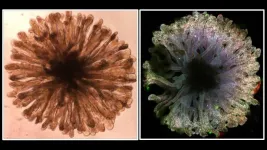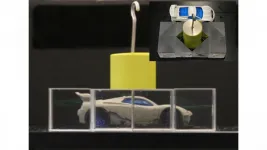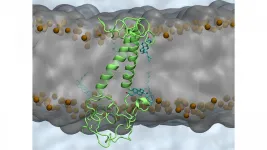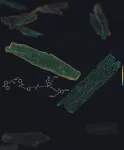USC Stem Cell scientists make big progress in building mini-kidneys
The organoids, which resemble a kidney's uretic buds, provide a way to study kidney disease that could lead to new treatments and regenerative approaches for patients
2021-06-15
(Press-News.org) A team of scientists at the Keck School of Medicine of USC has created what could be a key building block for assembling a synthetic kidney. In a new study in Nature Communications, Zhongwei Li and his colleagues describe how they can generate rudimentary kidney structures, known as organoids, that resemble the collecting duct system that helps maintain the body's fluid and pH balance by concentrating and transporting urine.
"Our progress in creating new types of kidney organoids provides powerful tools for not only understanding development and disease, but also finding new treatments and regenerative approaches for patients," said Li, the study's corresponding author and an assistant professor of medicine, and of stem cell biology and regenerative medicine.
Creating the building blocks
The first authors of the study, PhD student Zipeng Zeng and postdoc Biao Huang, and the team started with a population of what are known as ureteric bud progenitor cells, or UPCs, that play an important role in early kidney development. Using first mouse and then human UPCs, the scientists were able to develop cocktails of molecules that encourage the cells to form organoids resembling uretic buds--the branching tubes that eventually give rise to the collecting duct system. The scientists also succeeded in finding a different cocktail to induce human stem cells to develop into ureteric bud organoids.
An additional molecular cocktail pushed ureteric bud organoids--grown from either mouse UPCs or human stem cells--to reliably develop into even more mature and complex collecting duct organoids.
The human and mouse ureteric bud organoids can also be genetically engineered to harbor mutations that cause disease in patients, providing better models for understanding kidney problems, as well as for screening potential therapeutic drugs. As one example, the scientists knocked out a gene to create an organoid model of congenital anomalies of the kidney and urinary tract, known as CAKUT.
In addition to serving as models of disease, ureteric bud organoids could also prove to be an essential ingredient in the recipe for a synthetic kidney. To explore this possibility, the scientists combined mouse ureteric bud organoids with a second population of mouse cells: the progenitor cells that form nephrons, which are the filtering units of the kidney. After inserting the tip of a lab-grown ureteric bud into a clump of NPCs, the team observed the growth of an extensive network of branching tubes reminiscent of a collecting duct system, fused with rudimentary nephrons.
"Our engineered mouse kidney established a connection between nephron and collecting duct--an essential milestone towards building a functional organ in the future," said Li.
INFORMATION:
About the Study
The project brought together scientists from the END
[Attachments] See images for this press release:

ELSE PRESS RELEASES FROM THIS DATE:
2021-06-15
What The Study Did: In this survey of 1,186 medical, graduate and health professional school faculty, more faculty considered leaving since the COVID-19 pandemic than before. Faculty with children, particularly female faculty with children, were more likely to consider leaving since the pandemic.
Authors: Susan A. Matulevicius, M.D., M.S.C.S., of the University of Texas Southwestern in Dallas, is the corresponding author.
To access the embargoed study: Visit our For The Media website at this link https://media.jamanetwork.com/
(doi:10.1001/jamanetworkopen.2021.13539)
Editor's Note: Please ...
2021-06-15
What The Study Did: Researchers examined whether a sweetened beverage tax in Philadelphia was associated with sustained changes in beverage prices and purchases of sweetened beverages and high-sugar foods two years after implementation of the tax.
Authors: Christina A. Roberto, Ph.D., of the University of Pennsylvania Perelman School of Medicine in Philadelphia, is the corresponding author.
To access the embargoed study: Visit our For The Media website at this link https://media.jamanetwork.com/
(doi:10.1001/jamanetworkopen.2021.13527)
Editor's Note: The article includes conflicts of interest ...
2021-06-15
What The Study Did: Focus groups were conducted with teenagers to examine their responses to exposure to online and media-based vicarious racism and to explore coping strategies that may be used to combat negative emotions.
Authors: Nia Heard-Garris, M.D., M.Sc., of Ann and Robert H. Lurie Children's Hospital of Chicago, is the corresponding author.
To access the embargoed study: Visit our For The Media website at this link https://media.jamanetwork.com/
(doi:10.1001/jamanetworkopen.2021.13522)
Editor's Note: The article includes conflicts of interest and funding/support disclosures. Please ...
2021-06-15
WASHINGTON, June 15, 2021 -- Optical cloaking allows objects to be hidden in plain sight or to become invisible by guiding light around anything placed inside the cloak. While cloaking has been popularized in fiction, like in the "Harry Potter" books, researchers in recent years have started realizing cloaks that shield objects from view by controlling the flow of electromagnetic radiation around them.
In the Journal of Applied Physics, by AIP Publishing, researchers from the Toyota Research Institute of North America examined recent progress of developing invisibility ...
2021-06-15
WASHINGTON, June 15, 2021 -- Alzheimer's disease is predominant in elderly people, but the way age-related changes to lipid composition affect the regulation of biological processes is still not well understood. Links between lipid imbalance and disease have been established, in which lipid changes increase the formation of amyloid plaques, a hallmark of Alzheimer's disease.
This imbalance inspired researchers from Aarhus University in Denmark to explore the role of lipids comprising the cellular membranes of brain cells.
In Biointerphases, by AIP Publishing, the researchers report on the significant role lipids may play in regulating C99, a protein within the amyloid pathway, and disease progression. Lipids have been mostly overlooked from a therapeutic standpoint, likely because ...
2021-06-15
A tickle in the nose can help trigger a sneeze, expelling irritants and disease-causing pathogens. But the cellular pathways that control the sneeze reflex go far beyond the sinuses and have been poorly understood. Now, a team led by researchers at Washington University School of Medicine in St. Louis has identified, in mice, specific cells and proteins that control the sneeze reflex.
"Better understanding what causes us to sneeze -- specifically how neurons behave in response to allergens and viruses -- may point to treatments capable of slowing the spread of infectious respiratory diseases via sneezes," said Qin Liu, PhD, an associate professor of anesthesiology and the study's senior investigator.
The findings are published June 15 in the journal ...
2021-06-15
Research led by the University of Kent and the STFC Rutherford Appleton Laboratory has resulted in the discovery of a new rare topological superconductor, LaPt3P. This discovery may be of huge importance to the future operations of quantum computers.
Superconductors are vital materials able to conduct electricity without any resistance when cooled below a certain temperature, making them highly desirable in a society needing to reduce its energy consumption.
Superconductors manifest quantum properties on the scale of everyday objects, making them highly attractive candidates for building computers which use quantum physics to store data ...
2021-06-15
In the heart there are two different subtypes of beta-adrenergic receptors - beta1 and beta2 - which are activated by the stress hormones adrenaline and noradrenaline. They both trigger the strongest stimulation of the heart rate and pumping capacity that we know of. The two subtypes are highly similar biochemically, but differ substantially in terms of their functional and therapeutic relevance.
Both receptor types can stimulate the heart in the short term, yet when the beta1 receptor is activated over a prolonged period of time, it has a range ...
2021-06-15
DUBLIN, June 15, 2021 - Scientists have identified how and why some Covid-19 patients can develop life-threatening clots, which could lead to targeted therapies that prevent this from happening.
The work, led by researchers from RCSI University of Medicine and Health Sciences, is published in the END ...
2021-06-15
A new antibody testing study examining samples originally collected through the National Institutes of Health's All of Us Research Program found evidence of SARS-CoV-2 infections in five states earlier than had initially been reported. These findings were published in the journal Clinical Infectious Diseases. The results expand on findings from a Centers for Disease Control and Prevention study that suggested SARS-CoV-2, the virus that causes COVID-19, was present in the U.S. as far back as December 2019.
In the All of Us study, researchers analyzed more than 24,000 stored blood samples contributed ...
LAST 30 PRESS RELEASES:
[Press-News.org] USC Stem Cell scientists make big progress in building mini-kidneys
The organoids, which resemble a kidney's uretic buds, provide a way to study kidney disease that could lead to new treatments and regenerative approaches for patients




